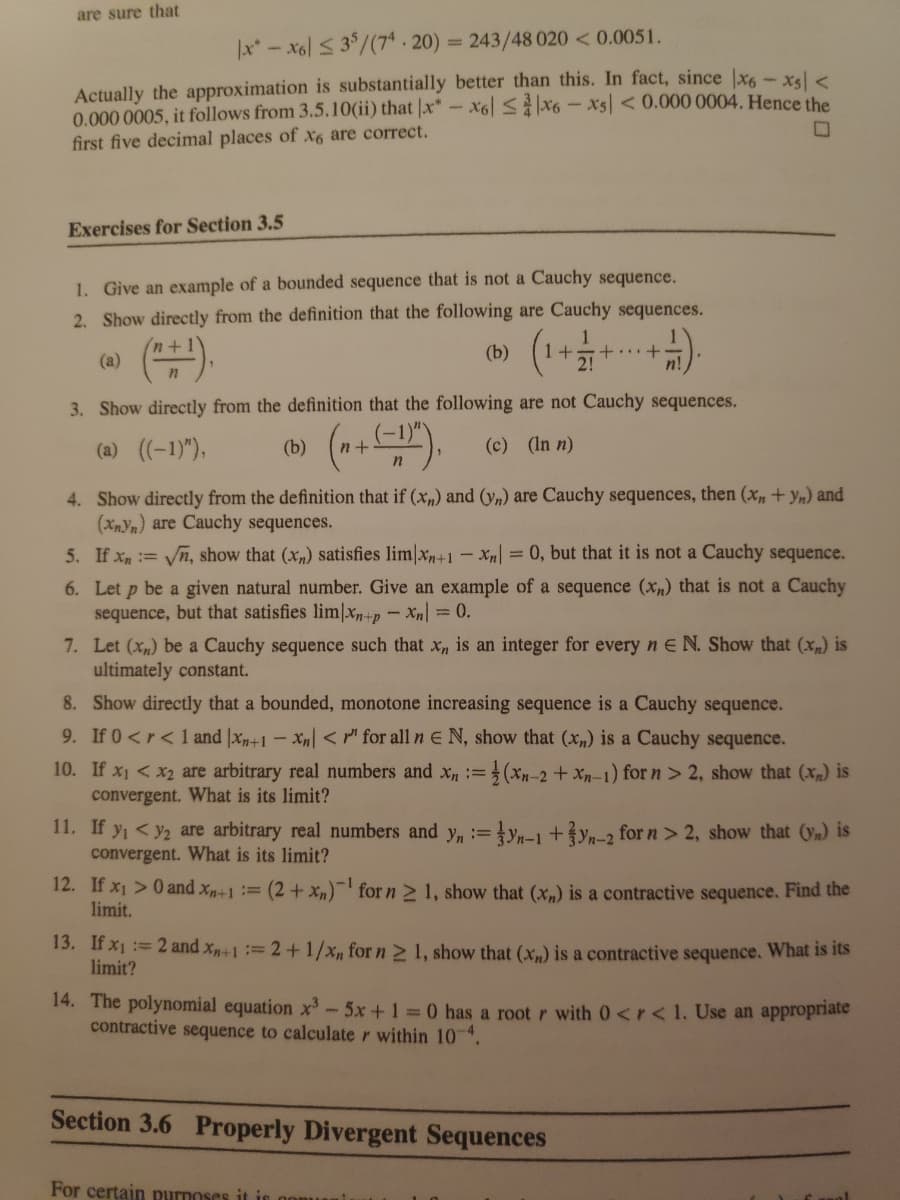13. If x1 := 2 and x+1 = 2+1/x, for n 2 1, show that (x,) is a contractive sequence. What is its limit?
13. If x1 := 2 and x+1 = 2+1/x, for n 2 1, show that (x,) is a contractive sequence. What is its limit?
Algebra & Trigonometry with Analytic Geometry
13th Edition
ISBN:9781133382119
Author:Swokowski
Publisher:Swokowski
Chapter6: The Trigonometric Functions
Section6.4: Values Of The Trigonometric Functions
Problem 22E
Related questions
Question
100%
Question number (13) only.
This material is Real analysis .

Transcribed Image Text:are sure that
x-x6l 3/(7* - 20) = 243/48 020 < 0.0051.
Actually the approximation is substantially better than this. In fact, since |x6- xsl <
0.000 0005, it follows from 3.5.10(ii) that |x" - x6 Sx6 - x5 < 0.000 0004. Hence the
first five decimal places of x6 are correct.
Exercises for Section 3.5
1. Give an example of a bounded sequence that is not a Cauchy sequence.
2. Show directly from the definition that the following are Cauchy sequences.
(1
(a)
(b)
+...+
2!
3. Show directly from the definition that the following are not Cauchy sequences.
(*).
(a) (-1)"),
(b)
(c) (In n)
4. Show directly from the definition that if (xn) and (yn) are Cauchy sequences, then (x,+ yn) and
(XnYn) are Cauchy sequences.
= 0, but that it is not a Cauchy sequence.
5. If Xn= n, show that (x,) satisfies lim|xn+1- X|
6. Let p be a given natural number. Give an example of a sequence (Xn) that is not a Cauchy
sequence, but that satisfies lim|xn+p - Xn = 0.
7. Let (x) be a Cauchy sequence such that x, is an integer for every n E N. Show that (x) is
ultimately constant.
8. Show directly that a bounded, monotone increasing sequence is a Cauchy sequence.
9. If 0<r< 1 and x+1 - x„ < " for all n E N, show that (xn) is a Cauchy sequence.
10. If x1 < x2 are arbitrary real numbers and x, = (Xn-2 + Xn-1) for n> 2, show that (x) is
convergent. What is its limit?
11. If yi <y2 are arbitrary real numbers and y, := }yn-1 +?yn-2 for n > 2, show that (y) is
convergent. What is its limit?
!i!
12. If x1 > 0 and xn+1= (2 + xn)-for n 2 1, show that (x„) is a contractive sequence. Find the
limit,
13. If x1 := 2 and x+1 := 2 +1/x, for n > 1, show that (x) is a contractive sequence. What is its
limit?
14. The polynomial equation x-5x+1 0 has a root r with 0<r< 1. Use an appropriate
contractive sequence to calculate r within 104.
Section 3.6 Properly Divergent Sequences
For certain purnoses it i oom
Expert Solution
This question has been solved!
Explore an expertly crafted, step-by-step solution for a thorough understanding of key concepts.
This is a popular solution!
Trending now
This is a popular solution!
Step by step
Solved in 3 steps with 2 images

Knowledge Booster
Learn more about
Need a deep-dive on the concept behind this application? Look no further. Learn more about this topic, advanced-math and related others by exploring similar questions and additional content below.Recommended textbooks for you

Algebra & Trigonometry with Analytic Geometry
Algebra
ISBN:
9781133382119
Author:
Swokowski
Publisher:
Cengage

Algebra & Trigonometry with Analytic Geometry
Algebra
ISBN:
9781133382119
Author:
Swokowski
Publisher:
Cengage